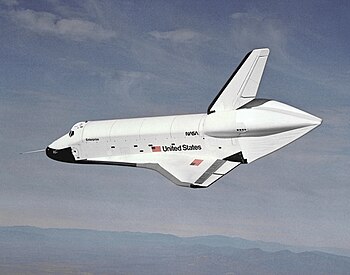Space Shuttle Enterprise

The Shuttle Orbiter Enterprise (NASA Designation: OV-101) was the first Space Shuttle built for NASA. It was initially constructed without engines or a functional heat shield and was therefore not capable of space operations without a refit. It was intended to be the second space shuttle to fly after the Space Shuttle Columbia even though Enterprise was built first; however, it was found to be cheaper to refit a test article (STA-099) into the Space Shuttle Challenger. Similarly, it was considered for refit to replace Challenger, but Space Shuttle Endeavour was built from spares instead.
Originally planned to be called Constitution, the test vehicle was renamed following a write-in campaign, after the starship featured on the television show Star Trek, which in turn was named for the various ships named USS Enterprise. Ironically, a mural in the captain's office in Star Trek: The Next Generation depicts this Space Shuttle as one of the starship's own namesakes, and images in the opening credits of the series Star Trek: Enterprise pay similar tribute. Oddly, Star Trek: Deep Space Nine later pictured a model of the International Space Station with the Space Shuttle Enterprise docked with it, despite the fact that the Enterprise has never been fitted for launch into space.

Enterprise was used by NASA for a variety of ground and flight tests intended to validate aspects of the shuttle program. The initial nine-month testing period was referred to by the acronym ALT for "Approach and Landing Test". These tests included a maiden "flight" on February 18, 1977 atop a Boeing 747 shuttle carrier aircraft (SCA) to measure structural loads and ground handling and braking characteristics of the mated system. Ground tests of all orbiter subsystems were carried out to verify functionality prior to atmospheric flight.
The mated Enterprise/SCA combination was then subjected to five test flights with Enterprise unmanned and unactivated. The purpose of these test flights was to measure the flight characteristics of the mated combination. These tests were followed with three test flights with Enterprise manned in order to test the shuttle flight control systems.
Finally, Enterprise underwent five free flights where the craft separated from the SCA and was landed under astronaut control. These tests verified the craft's flight characteristics and were carried out under several aerodynamic and weight configurations.
Following the ALT program, Enterprise was ferried between several NASA facilities to configure the craft for vibration testing. Ultimately it was mated with an external tank and solid rocket boosters and tested in a launch configuration.
With the completion of critical testing, Enterprise was partially disassembled to allow certain components to be reused in other shuttles, then underwent a world tour visiting France, Germany, Italy, the United Kingdom, Canada, and the US states of California, Alabama, and Louisiana. It was also used to fit-check the never-used shuttle launch pad at Vandenberg AFB, California. Finally, on November 18, 1985, Enterprise was ferried to Washington, D.C., where it became property of the Smithsonian Institution.
Enterprise was at the Smithsonian's hangar at Washington Dulles International Airport before being moved to the Smithsonian's National Air and Space Museum's Steven F. Udvar-Hazy Center at Dulles, where it is on display.


